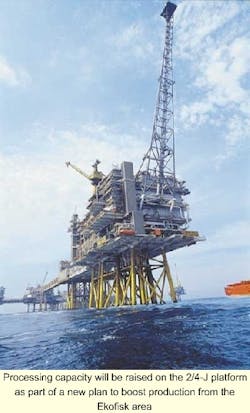NORWAY: Ekofisk moves to next stage with 30 additional wells
Phillips Petroleum Company Norway (PPCN) is preparing for a further stage of development of the prolific Ekofisk field. A new project that the company is preparing combines a further boost to production with the need to reduce produced water discharges.
Ekofisk, which this year celebrates its 30th anniversary since it became the first field to come onstream in the Norwegian sector, is still capable of producing pleasant surprises. PPCN President Lars Takla recently revealed that the estimate for recoverable reserves is now the same as it was at start-up - 1.76 billion bbl. The company was recently awarded the Norwegian Petroleum Directorate's prize for improved oil recovery.
The field started on a new lease of production life when the Ekofisk II development came onstream in August 1998. Drilling and process operations then became centered on two modern platforms, Ekofisk 2/4-X and 2/4-J respectively, while a dozen older platforms became redundant.
On the basis of a constantly updated reservoir model that incorporates the latest drilling, production and subsidence data, Phillips now sees the possibility of extending the lifetime of older platforms and further boosting production by drilling approximately 30 additional wells. The feasibility of this plan, which could involve investments of some NKr 1.4 billion, is now being studied, according to project manager Bard Atle Hovd.
30 more wells
Assuming the plan proves viable, the company hopes to start pre-engineering work in October and achieve full sanction from the license in the third quarter of 2002. First production from the new wells could come in 2004-05. .
As part of the plan, considerable modification work would have to be carried out on Ekofisk 2/4-J and two Eldfisk platforms - the 2/7-FTP treatment platform and 2/7-B wellhead platform. Lesser modifications will also be called for on Ekofisk Field wellhead and water injection platforms, Hovd says. Some of this work will be aimed at increasing liquids processing capacity, but with the field's gas/oil ratio (GOR) in decline, there will be no need to boost gas handling capacity.
The plan involves only reserves covered by the PL 018 license. In addition to Ekofisk and Eldfisk, fresh reserves may be developed at Tjalve, while Ekofisk West, which ceased production in 1998, could be redeveloped. The production boost could raise oil output from the Ekofisk area fields to around 400,000 b/d.
In the wake of the Ekofisk II project and the increase in water injection on both Ekofisk and Eldfisk, which followed the installation last year of a new injection platform on Eldfisk serving both fields, production has been lifted this year to around 350,000 b/d, making it the leading produc-tion area on the Nor- wegian continental shelf.
Meanwhile two concepts are being studied that could contribute to reaching the objective of zero discharge of untreated produced water. One is the re-injection of produced water beneath the seabed, and the other is the C-Tour process for treating produced water. C-Tour is under development by Rogaland Research under a joint industry project in which Phillips is one of the sponsors.
